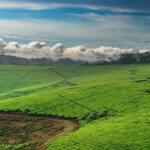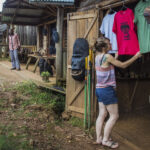Queen Elizabeth National Park (QENP), spanning 1,978 km², boasts a breathtaking location within the Rift Valley, nestled between Lakes Edward and George. Its diverse habitats support an impressive array of wildlife: 95 mammal species and a remarkable 612 bird species. Douglas Willocks’ insightful description from forty years ago, highlighting the park’s diverse features, remains the most captivating introduction to this area, established in 1952.
Willocks eloquently captured the scenery: ‘To the north, the majestic Rwenzori Mountains, a jagged, 60-mile-long and 40-mile-wide range, rise from the plains. Across Lake Edward to the west, the Mitumbe hills, verdant and steep, stand sentinel on the Congo border. The eastern boundary is marked by the calm, green escarpment of the western Rift Valley. And between these dramatic features stretches an endless savanna, punctuated by the distinctive candelabra euphorbia trees.

Elephants in Queen Elizabeth National Park
QENP is part of a larger network of protected areas, including the Kigezi (256 km²) and Kyambura (154 km²) Wildlife Reserves, Kalinzu Forest Reserve, and, across the border in the Democratic Republic of Congo (DRC), Virunga National Park (200 km²). Rwenzori National Park lies a short distance to the north.
The park is divided into different sectors, and each offers a different experience. To enjoy the most of what the park has to offer, the visitor needs to have at least 3 or 7 days in the park. Below are the common sectors you will explore in the park
Mweya Peninsula
This is one of the most common areas in the Queen Elizabeth National Park. It is found on the northern bank of the Kazinga Channel, which is a 32-kilometer natural channel that connects two lakes, Edward and Goerge. This channel is one of the most important attractions in the park, it attracts a lot of animals that come to drink water. Here in Mweya Peninsula, you will get a chance to do a boat cruise on Kazinga Channel. game drive, you will see many animals.
Kasenyi Sector
This sector is found in the northeastern part of the park. It commonly features a savanna and is known for game drive and lion tracking.
Ishasha Sector

Tree Climbing Lion in Ishasha Sector
Ishasha Sector, a picturesque part of Queen Elizabeth National Park in Uganda, is renowned for its tree-climbing lions, a rare and fascinating sight. Located in the southwestern part of the park near the border with the Democratic Republic of Congo, Ishasha offers breathtaking savannah landscapes dotted with fig trees. This area is also home to diverse wildlife, including elephants and antelopes, making it a favorite destination for nature enthusiasts. It’s famous for its tree climbing lions
Kyambura Gorge Sector
This Gorge, famously known as the “Valley of Apes,” is a scenic and lush valley in Queen Elizabeth National Park. It lies in the western region of the park, near the Kazinga Channel. The gorge is renowned for its rich biodiversity, including primates like chimpanzees and diverse bird and plant species. Visitors can explore its captivating
Other notable sectors
Maramagambo Forest: Known for its diverse wildlife and birdlife
Katwe-Kikorongo Area: Home to unique crater lakes and wildlife
Northeast Escarpment and Rift Valley Escarpment: These areas offer scenic views and diverse habitats
What to do in Queen Elizabeth National Park
Since the park is one of the most loved and visited destinations in the country, there are a variety of activities you can enjoy on your safari to the park, and below are some of the most common tourist activities a tourist can enjoy in Queen Elizabeth National Park.
Game Drive in Queen Elizabeth National Park
Game drives in Queen Elizabeth National Park are done in the morning, afternoon, and evening, and they offer an amazing opportunity to explore the diverse wildlife in the park. Visitors can enjoy guided tours through scenic savannahs, forests, and wetlands, spotting animals like elephants, lions, buffaloes, and antelopes. Morning and evening game drives are especially rewarding for breathtaking views and unforgettable wildlife encounters in the park.
Birding in Queen Elizabeth National Park

Birds in Queen Elizabeth National Park
Queen Elizabeth National Park is known as one of the best safari destinations for bird lovers, boasting over 600 bird species. This makes it one of the richest birding destinations in Africa. The park’s diverse habitats, including savannahs, wetlands, forests, and lakeshores, support a wide variety of birdlife. Notable species include the Shoebill, Grey-crowned Crane, African Fish Eagle, the Great Blue Turaco, and many others.
Migratory birds use the park as a crucial migration route during Europe’s winter months. The major bird-watching locations —the Kazinga Channel, Maramagambo Forest, and Ishasha Sector—provide diverse bird species viewing experiences.
Boat Cruise in Queen Elizabeth National Park
Boat cruise in Queen Elizabeth National Park is done on the Kazinga channel. The cruise takes 2 hours and offers amazing views of different animals like hippos, crocodiles, buffaloes, and many others, plus a variety of bird life.


